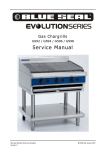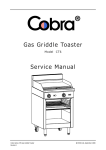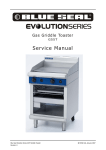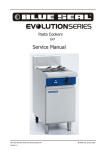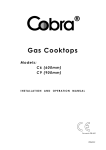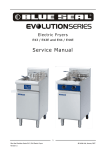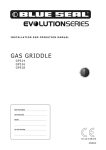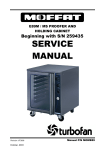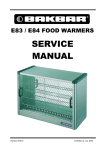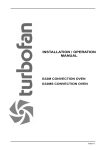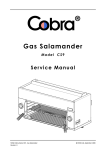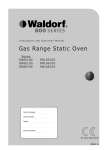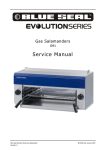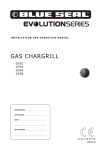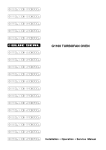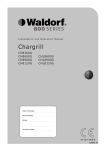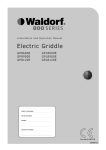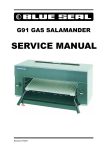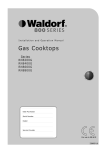Download Blue Seal G57 Service manual
Transcript
Gas Ta rget Tops G57 Service Manual Blue Seal Evolution Series Gas Target Tops Revision 1/ © Moffat Ltd, January 2007 WARNING: ALL INSTALLATION AND SERVICE REPAIR WORK MUST BE CARRIED OUT BY QUALIFIED PERSONS ONLY. IMPORTANT: MAKING ALTERATIONS MAY VOID WARRANTIES AND APPROVALS. Blue Seal Evolution Series Gas Target Tops Revision 1/ © Moffat Ltd, January 2007 Contents This manual is designed to take a more in depth look at the G57 Target Top for the purpose of making the units more understandable to service people. There are settings explained in this manual that should never require to be adjusted, but for completeness and those special cases where these settings are required to change, this manual gives a full explanation as to how, and what effects will result. Section Page Number 1. Specifications ............................................................................................ 1 2. Installation ................................................................................................ 6 3. Operation ................................................................................................. 10 4. Cleaning / Maintenance .......................................................................... 12 5. Trouble-shooting Guide ........................................................................... 23 5.1 5.2 6. Trouble Shooting Chart Fault Diagnosis Service Procedures .................................................................................. 15 6.1 6.2 6.3 Access Replacement Adjustment/Calibration 7. Accessories .............................................................................................. 20 8. Exploded Parts Diagrams ....................................................................... 21 8.1 8.2 9. Target Top Base Options Service Contacts ...................................................................................... 27 Appendix A. Gas Type Conversion.................................................................. 29 Blue Seal Evolution Series Gas Target Tops Revision 1/ © Moffat Ltd, January 2007 Blue Seal Evolution Series Gas Target Tops Revision 1/ © Moffat Ltd, January 2007 Specifications 1 Model: G57-LS Rating Plate Location Front Side Plan Weight (Nett) G57 - LS 180 kg. Gas Connection Point. 1 Blue Seal Evolution Series Gas Target Tops Revision 1/ © Moffat Ltd, January 2007 1 Specifications Model: G57-B Rating Plate Location Front Side Plan Weight (Nett) G57 - B Gas Connection Point. 160 kg. 2 Blue Seal Evolution Series Gas Target Tops Revision 1/ © Moffat Ltd, January 2007 Specifications 1 G57-CB Rating Plate Location Front Side Plan Weight (Nett) G57 - CB 200 kg. Gas Connection Point. 3 Blue Seal Evolution Series Gas Target Tops Revision 1/ © Moffat Ltd, January 2007 1 Specifications G57-RB Rating Plate Location (View through slots in door) Front Side Electrical Connection Point. Gas Connection Point. Plan Weight (Nett) G57 - RB 240 kg (Including the Refrigeration Cabinet.) 4 Blue Seal Evolution Series Gas Target Tops Revision 1/ © Moffat Ltd, January 2007 Specifications 1 Model Numbers covered in this Specification G57 - LS G57 - B G57 - CB 900mm wide Gas target top hob on leg stand 900mm wide Gas target top bench mount hob 900mm wide Gas target top hob with base cabinet Gas Supply Requirements - Non UK Only Input Rate (N.H.G.C.) Gas Supply Pressure Burner Operating Pressure Natural Gas LP Gas (Propane) 45 MJ/hr (42,650 Btu/hr) 45 MJ/hr (42,650 Btu/hr) 1.13 - 3.40 kPa (4.5” - 13.5” w.c.) 1.0 kPa (*) (4.0” w.c.) 2.75 - 3.40 kPa (11” - 13.5” w.c.) 2.60 kPa (*) (10.0” w.c.) 3 Gas Connection /4” B.S.P. Male - UK Only Appliance Classification Category: Flue Type: Heat Input (nett) Gas Rate (nett) II2H3P. A1. Natural Gas (G20) Propane (G31) Nominal Reduced 11.5 kW 4.7 kW 11.5 kW 7.9 kW Nominal 1.22 m3/hr 0.89 kg/hr 3 Reduced Supply Pressure Burner Operating Pressure 0.61 kg/hr 20 mbar 37 mbar 9.8 mbar (*) 27 mbar (*) 3 Gas Connection * 0.50 m /hr /4” B.S.P. Male The burner operating pressure is to be measured at the target top hob manifold test point with the target top burner (Inner and outer ring) operating at full setting. The operating pressure is exfactory set through the appliance regulator and is not to be adjusted, apart from when carrying out gas conversion, if required. (Refer to the ‘Gas Conversion’ section for details). Injector Sizes Natural Gas LPG Target Top Pilot 0.30mm 0.20mm Target Top Inner Ring 1.70 mm 1.10 mm Target Top Outer Ring 2.60 mm 1.55 mm 5 Blue Seal Evolution Series Gas Target Tops Revision 1/ © Moffat Ltd, January 2007 2 Installation Installation Requirements NOTE: • It is most important that this Target Top is installed correctly and that operation is correct before use. Installation shall comply with local gas, health and safety requirements. • This appliance shall be installed with sufficient ventilation to prevent the occurrence of unacceptable concentrations of health harmful substances in the room, the appliance is installed in. Blue Seal Top Target Tops are designed to provide years of satisfactory service, and correct installation is essential to achieve the best performance, efficiency and trouble-free operation. This appliance must be installed in accordance with National installation codes and in addition, in accordance with relevant National / Local codes covering gas, electrical and fire safety. AUSTRALIA: NEW ZEALAND: UNITED KINGDOM IRELAND: - AS5601 - Gas Installations. - NZS5261 - Gas Installation. - Gas Safety (Installation & Use) Regulations 1998. - BS6173 - Installation of Catering Appliances. - BS5440 1 & 2 - Installation Flueing & Ventilation. - BS7671 Requirements for Electrical Installation. - IS 820 - Non - Domestic Gas Installations. Installations must be carried out by authorised persons only. Failure to install equipment to the relevant codes and manufacturer’s specifications shown in this section will void the warranty. Components having adjustments protected (e.g. paint sealed) by the manufacturer are only allowed to be adjusted by an authorised service agent. They are not to be adjusted by the installation person. Unpacking • Remove all packaging and transit protection from the appliance including all protective plastic coating from the exterior stainless steel panels. • Check equipment and parts for damage. Report any damage immediately to the carrier and distributor. • Ensure that the 4 adjustable feet are fitted with the protruding centre screw. (Not fitted on G57 RB Models). • Report any deficiencies to the distributor who supplied the appliance. • Check that the available gas supply is correct to that shown on the rating plate. Refer to the ‘Dimensions’ section for rating plate locations for the different models. Location 1. Installation must allow for a sufficient flow of fresh air for the combustion air supply. Combustion Air Requirements: Natural Gas 12 m3/hr LPG 12 m3/hr 2. 3. 4. 5. 6. Installation must include adequate ventilation means, to prevent dangerous build up of combustion products. Never directly connect a ventilation system to the appliance flue outlet. Any gas burning appliance requires adequate clearance and ventilation for optimum and trouble-free operation. The minimum installation clearances shown below are to be adhered to. Position the target top in its approximate working position. All air for burner combustion is supplied from underneath the appliance. The legs must always be fitted and no obstructions placed on the underside or around the base of the appliance, as obstructions will cause incorrect operation and/or failure of the appliance. NOTE: Do not obstruct or block the appliances flue. Never directly connect a ventilation system to the appliance flue outlet. 6 Blue Seal Evolution Series Gas Target Tops Revision 1/ © Moffat Ltd, January 2007 Installation 7. 2 If the Target Top is fitted with a Refrigeration Cabinet, the cabinet must NOT be installed in an explosive environment, the open air or exposed to rain. The following considerations should be made;• The Cabinet must be located away from heat sources (radiators ovens and other heat generating kitchen appliances) and direct sunlight. • Must be protected from draughts. • Air circulation around the condensing unit must not be obstructed. Clearances NOTE: Only non-combustible materials can be used in close proximity to this appliance. -B/-CB/-LS models: Left/Right Hand Side Rear -RB model: Sides / Rear Combustible Surface Non Combustible Surface 50 mm 50 mm 0 mm 0 mm 75 mm 75 mm * * For additional clearances information refer to the Refrigeration Cabinet Installation and Operation Manual supplied with the Refrigeration Cabinet. Assembly NOTE: • The Leg Stand Model (G57-LS), will require assembly. Refer to the 'Leg Stand Models Only' information below for assembly instructions. • All Models are delivered completely assembled. No further assembly is required, with the exception of the Leg Stand Model (G57-LS), this will require assembly. Refer to the Fitting of Adjustable Feet / Rear Rollers to Leg Stand Units' information below for assembly instructions. • The appliance rear leg housings can be fitted with:Adjustable feet to assist with levelling of the appliance on uneven floors. Rear rollers to enable the appliance to be easily moved for positioning and cleaning purposes. Optional Accessories (Refer to Replacement Parts List) • Plinth Kit. For installation details, refer to the instructions supplied with each kit. Bench Models 1. Check that all the feet (and castors) are securely fitted. 2. Adjust the feet to make the Target Top steady and level. 7 Blue Seal Evolution Series Gas Target Tops Revision 1/ © Moffat Ltd, January 2007 2 Installation Gas Connection NOTE: ALL GAS FITTING MUST ONLY BE CARRIED OUT BY AN AUTHORISED PERSON. 1. 2. Blue Seal Target Tops do not require an electrical connection, as they function totally on the gas supply only. It is essential that the gas supply is correct for the target top to be installed and that adequate supply pressure and volume are available. The following checks should therefore be made before installation:a. Gas Type the appliance has been supplied for is shown on the coloured sticker located above the gas connection and next to the rating plate. Check that this is correct for the gas supply the appliance is being installed for. The gas conversion procedure is detailed in this manual. b. Supply Pressure required for this appliance is shown in the “Specifications” section of this manual. Check the gas supply to ensure adequate supply pressure exists. c. Input Rate of this appliance is stated on the Rating Plate and in the “Specifications” section of this manual. The input rate should be checked against the available gas supply line capacity. Particular note should be taken if the target top is being added to an existing installation. NOTE: It is important that adequately sized piping runs directly to the connection joint on the appliance with as few tees and elbows as possible to give maximum supply volume. 3. Fit the gas regulator supplied, into the gas supply line as close to the appliance as possible. NOTE: The gas pressure regulator provided with this appliance is convertible between Natural Gas and LPG and is already converted ex-factory to the gas type labelled beside the gas connection point. The regulator outlet pressure is fixed ex-factory and it is NOT to be adjusted. The regulator connections are 3/4" BSP female. The connection to the appliance is 3/4" BSP male. (Refer to the “Specifications” section for the gas supply location dimensions). NOTE: A Manual Isolation Valve must be fitted to the individual appliance supply line. 4. 5. 6. Correctly locate the appliance into its final operating position and using a spirit level, adjust the legs so that the unit is level and at the correct height. Connect the gas supply to the appliance. A suitable jointing compound which resists the breakdown action of LPG must be used on every gas line connection, unless compression fittings are used. Check all gas connections for leakages using soapy water or other gas detecting equipment. WARNING: DO NOT USE A NAKED FLAME TO CHECK FOR GAS LEAKAGES . 8 Blue Seal Evolution Series Gas Target Tops Revision 1/ © Moffat Ltd, January 2007 Installation 7. 2 Check that the gas operating pressure is as shown in the “Specifications” section. NOTE: The operating pressure to be measured at the manifold test point and with the burner operating at the “High Flame” setting. 8. 9. 10. Turn off the mains gas supply and bleed the gas out of the appliance gas lines. Turn on the gas supply and the appliance. Verify the operating pressure remains correct. NOTE: This appliance is fitted with adjustable feet to enable the appliance to be positioned securely and level. This should be carried out on completion of the gas connection. Gas Pressure Test Point Commissioning Before leaving the new installation; Check the following functions in accordance with the operating instructions specified in the “Operation” section of the User manual. • Light the Pilot Burner. • Light the Main Burner. • Check the Low Fire burner operation. • Check the High Fire burner operation. Ensure that the operator has been instructed in the areas of correct lighting, operation, and shutdown procedure for the appliance. The User manual must be kept by the owner for future reference, and a record of Date of Purchase, Date of Installation and Serial Number of the Appliance recorded and kept with the manual. (These details can be found on the Rating Plate. Refer to the ‘Dimensions’ section for Rating Plate location for all models). NOTE: If for some reason it is not possible to get the appliance to operate correctly, shut off the gas supply and contact the supplier of this appliance. For the Refrigeration Cabinet Installation details refer to the Refrigeration Cabinet Installation and Operation manual supplied with the appliance. 9 Blue Seal Evolution Series Gas Target Tops Revision 1/ © Moffat Ltd, January 2007 3 Operation Description of Controls Pilot Burner Viewing Hole Gas Control Knob OFF Position PILOT Burner HIGH Flame LOW Flame 10 Blue Seal Evolution Series Gas Target Tops Revision 1/ © Moffat Ltd, January 2007 Operation 3.2 Inside the body of the gas valve is an electromagnet connected to a spring loaded plunger. When the electromagnet is energized, it holds the plunger in, allowing gas to flow through the valve. When the electromagnet is de-energized, the plunger snaps to the closed position, stopping the flow of gas. Explanation of Control System Safety System The purpose of the safety system is to shut off the flow of gas if the pilot flame goes out. It is comprised of the flame itself, the thermocouple, and the flame failure gas valve. Thermocouple The pilot flame is lit by holding in the gas control knob, which in turn temporarily pushes the plunger inside the safety valve open and allows gas to flow through. Once the burner is lit, the thermocouple will begin to generate millivolts (after about 10 to 30 seconds of being heated) and will energize the electromagnet inside the gas valve. Once energized the electromagnet holds the plunger inside the gas valve in the open position. The plunger has to have been pushed all the way in for the electromagnet to be able to hold it in place. If the burner flame goes out for some reason, the thermocouple will cool after about 10 to 30 seconds and stop generating millivolts. The electromagnet will then de-energize, and the plunger will snap shut, cutting off the flow of gas. Electromagnet Shaft Knob Gas flow Figure 3.2b Millivolts are provided to the electromagnet by the thermocouple (not shown) which generates millivolts when heated. The thermocouple screws into a fitting at the back of the gas valve to make an electric connection. By pressing in the gas control knob, the plunger can be temporarily held open while lighting. There's two reasons for this; gas has to flow through the safety valve to make it possible to light the pilot burner, and secondly the plunger has to be pushed all the way in for the electromagnet to hold it in. I.e.; the electromagnet is strong enough to hold the plunger in once there, but is not strong enough to pull it in by itself. Sometimes a problem with the flame not staying lit after releasing the button can be attributed to not pushing the plunger all the way in. The thermocouple is a device that generates electricity when heat is applied to the tip. Interna l Wire Conductor Plunger Control Knob Thermocouple Nut Plunger Gas flow Detail of each component in the safety system is explained below. Insulator 3 Tip Figure 3.2a The tip of the thermocouple is located in the pilot burner flame, and the nut at the other end of the thermocouple screws into the back of the gas valve. Inside the copper tubing is a wire which is joined at the tip but insulated from the rest of the tubing. These two parts (the copper tubing and wire) make up the "wiring" for an electrical circuit. When these two dissimilar metals, wire and tip, are heated an electrical voltage is produced. This type of thermocouple generates between 7 and 30 millivolts when heated in the pilot flame. The Troubleshooting Guide (Section 5) should be used to identify any incorrect operation. On correct identification of the operating fault the Troubleshooting Guide will make reference to the corrective action required, or refer to the Fault Diagnosis section and/or Service section to assist in correction of the fault. Electromagnetic Flame Failure Gas Valve The purpose of the safety valve is to shut off the flow of gas if the pilot flame goes out. 11 Blue Seal Evolution Series Gas Target Tops Revision 1/ © Moffat Ltd, January 2007 4 Cleaning / Maintenance Caution: ALWAYS TURN OFF THE GAS SUPPLY BEFORE CLEANING. THIS UNIT IS NOT WATER PROOF. DO NOT USE WATER JET SPRAY TO CLEAN INTERIOR OR EXTERIOR OF THIS UNIT. 4.1 • 4.2 Cleaning Exterior Clean with detergent. Baked on deposits or discolouration may require a good quality stainless steel cleaner or stainless steel wool. Always apply cleaner when Target Top is cold and rub in the direction of the grain. Routine Maintenance Checks • To achieve the best results cleaning must be regular and thorough and all controls and mechanical parts checked and adjusted periodically by a competent serviceman. It is recommended that the unit is serviced every 6 months. If any small faults occur, have them attended to promptly. Don't wait until they cause a complete breakdown. Target Top Castings • DO NOT use water on castings while still hot as cracking may occur. Allow castings to cool and remove for cleaning. Clean with hot water, detergent solution and a scrubbing brush. Dry thoroughly with a dry cloth. Target Top • This should be kept clean of any build up of spillage’s of food. Provided the cast iron work surface is regularly used it will maintain itself in good condition with no special cleaning requirements being necessary. • Clean any food residue and spillage from the channels around the centre casting and main plates before use. 12 Blue Seal Evolution Series Gas Target Tops Revision 1/ © Moffat Ltd, January 2007 Trouble-shooting 5.1 5.1.1 5 Trouble Shooting Charts Target Top Fault Pilot won’t light Possible Cause Remedy No gas supply. Ensure gas supply is connected and on (bottles no empty). Gas pressure too low. Check gas supply pressure. (Refer specifications section) Blocked pilot injector. Clean or replace pilot injector. (Refer service section 6.2.3) Knob on gas control won’t go fully Remove obstruction / correct in. control panel mounting. Pilot flame small Faulty gas control. Replace gas control. (Refer service section 6.2.6) Gas pressure too low. Check gas supply pressure. (Refer specifications section) Pilot injector restricted. (Refer fault diagnosis 5.2.1) Clean or replace pilot injector. (Refer service section 6.2.3) Pilot goes out when knob released Releasing knob before the thermocouple heated. Pilot goes out when main burner comes on Main burners will not light Hold control in for longer (10 s), see if pilot will stay lit. Pilot flame too small. (Refer fault: Pilot Flame Small) Correct fault. Thermocouple faulty. (Refer fault diagnosis 5.2.1) Replace thermocouple. (Refer service section 6.2.1) Gas control magnet faulty. (Refer fault diagnosis 5.2.1) Replace gas magnet. (Refer service section 6.2.7) Incorrect gas pressure. Check supply / adjust pressure. (Refer specifications section) Faulty gas control. Replace gas control. (Refer service section 6.2.6) Incorrect supply pressure. Adjust supply pressure. Wrong size or blocked injectors. Replace / clean injectors. (Refer service section 6.2.5) Small pilot flame. (Refer fault: Pilot Flame Small) Correct fault. Faulty gas control. Replace gas control. (Refer service section 6.2.6) 13 Blue Seal Evolution Series Gas Target Tops Revision 1/ © Moffat Ltd, January 2007 5 Trouble-shooting 5.2 Fault Diagnosis Gas 5.2.1 Pilot drops out 5.2.2 Piezo ignitor not sparking Short in high tension lead If repeated sparking of the piezo shows intermittent sparking at the electrode, then the lead should be traced to find area of short. This can normally be visually seen as the spark arcs. If the lead is shorting the best solution is to replace it, as the electrical insulation strength of the lead may have deteriorated. Pilot flame too small If pilot can be lit but the flame is too small to impinge on the thermocouple, then check the gas pressure. If ok, remove pilot injector from pilot burner and check for blockages and/or correct size. If the spark arc can be seen at the electrode insulator at the pilot burner instead of at the electrode tip, then the insulator probably has a fracture and should be replaced. Thermocouple faulty Inspect thermocouple for build-up of carbon or food deposits on the tip. Clean off any deposits, taking care not to scratch off the aluminium coating on the thermocouple. Piezo ignitor faulty If no spark at all can be generated, remove piezo ignitor and hold close to the hob body, depress piezo ignitor and if a spark cannot be generated to hob body the piezo ignitor is faulty and should be replaced. Check that the thermocouple tip is in the flame zone of the pilot burner. When the burner is lit, the flame should impinge on the top 5mm of the thermocouple tip. NOTE: The thermocouple should not touch the burner. NOTE: If piezo ignition fails, the pilot can be manually lit in the interim until the piezo circuit is repaired. A standard taper torch or matches/ lighter can be used for manual back-up ignition. Check thermocouple connection to gas control is firm (loose connections will cause resistance in millivolt circuit and result in pilot outage). If connection is OK and above (step 1) has been checked and thermocouple flame will still not hold it is necessary to remove thermocouple and check millivolt circuit (refer section 6.3.1 for removing the thermocouple). Ensure gas is isolated / turned off at NOTE: the source. With a lighter apply a flame to the thermocouple tip insuring correct flame impingement. Using a multi meter (with the flame still being applied to the thermocouple tip) measure the voltage between the end of the thermocouple and earth (the body of the thermocouple). A good thermocouple should generate 20-30mV. If the thermocouple is giving less than 10mV, then it is faulty—replace. Gas magnet faulty If thermocouple millivoltage is above 10mV and the pilot still will not hold then the gas magnet is faulty - replace. 14 Blue Seal Evolution Series Gas Target Tops Revision 1/ © Moffat Ltd, January 2007 Service Procedures Section 6 Page no. 6.1 Access .................................................................................................... 16 6.1.1 Hob Control Panel .................................................................................................... 16 6.2 Replacement .......................................................................................... 16 6.2.1 6.2.2 6.2.3 6.2.4 6.2.5 6.2.6 6.2.7 Thermocouple ......................................................................................................... 16 Pilot Burner ............................................................................................................ 17 Pilot Injector............................................................................................................ 17 Main Burner ........................................................................................................... 17 Main Burner Injector ................................................................................................ 18 Gas Control Valve .................................................................................................... 18 Gas Control Magnet.................................................................................................. 18 6.3 Adjustment / Calibration ....................................................................... 19 6.3.1 6.3.2 6.3.3 Gas Control Re-Greasing........................................................................................... 19 Low Fire Rate Adjustment......................................................................................... 19 Burner Aeration Adjustment...................................................................................... 19 ALL INSTALLATION AND SERVICE REPAIR WORK MUST BE CARRIED OUT BY QUALIFIED PERSONS ONLY. WARNING: ENSURE GAS SUPPLY IS SWITCHED OFF BEFORE SERVICING ALWAYS CHECK / TEST FOR GAS LEAKS AFTER SERVICE REPAIRS ON THE GAS SYSTEM 15 Blue Seal Evolution Series Gas Target Tops Revision 1/ © Moffat Ltd, January 2007 6 Service Procedures 6.1 Access 6.2 Replacement-Target top 6.1.1 Control panel 6.2.1 Thermocouple 1) Remove target top castings. Remove control panel (refer 6.1.1). 1) Remove control knob. 2) Remove two screws from underside of control panel (one at each end). Panel can now be pulled out at the bottom and lifted off the top locating tags. 2) Remove two front refractory bricks, and undo the two burner securing screws. The main burner can now be removed. 3) Remove the right hand base refractory brick to allow access to the pilot burner assembly. Burner securing screws Refractory bricks to be removed Screws Figure 6.1.1 Figure 6.2.1a 4) Remove pilot assembly bracket screw and support bracket. Remove thermocouple from pilot burner bracket. Pilot assembly bracket screw Figure 6.2.1b 5) Remove right hand angled side refractory brick to allow access to the thermocouple gas control connection. 6) Remove thermocouple access panel. 7) Remove thermocouple from gas control. 8) Fit new thermocouple and reassemble in reverse order. NOTE: When screwing thermocouple back into gas control, once threaded up tighten up another ¼ turn only. Do not over-tighten. 16 Blue Seal Evolution Series Gas Target Tops Revision 1/ © Moffat Ltd, January 2007 6 Service Procedures 6.2.3 Pilot injector 1) Remove target top castings. 2) Remove two front refractory bricks, and undo the two burner securing screws. The main burner can now be removed. 3) Remove the right hand base refractory brick to allow access to the pilot burner assembly. Thermocouple access panel 4) Disconnect assembly. pilot supply line from pilot 5) Remove pilot assembly bracket screw and support bracket. Figure 6.2.1c 6) Remove pilot assembly and undo screw in bottom of injector mount, unscrew injector– replace. Thermocouple 7) Re-assemble in reverse order. Pilot injector Figure 6.2.3 Figure 6.2.1d 6.2.2 6.2.4 Pilot burner Main burner 1) Remove target top castings. 1) Remove target top castings. 2) Remove two front refractory bricks, and undo the two burner securing screws. The main burner can now be removed. 2) Undo two burner securing screws 3) Remove two refractory bricks at front of target top. 3) Remove the right hand base refractory brick to allow access to the pilot burner assembly. 4) Disconnect assembly. pilot supply line from 4) Lift out burner. 5) Replace and re-assemble in reverse order. pilot 5) Remove pilot assembly bracket screw and support bracket. Burner securing screws 6) Remove pilot burner– replace. 7) Re-assemble in reverse order. Refractory bricks to be removed Pilot assembly bracket screw Figure 6.2.4 NOTE: When refitting main burner, ensure that burner is pulled fully towards the front of the unit before tightening the two screws. Pilot assembly bracket screw Figure 6.2.2 17 Blue Seal Evolution Series Gas Target Tops Revision 1/ © Moffat Ltd, January 2007 6 Service Procedures 6.2.5 Main burner injectors 6.2.7 Gas control magnet 1) Remove control panel (refer 6.1.1). 1) Remove hob control panel (refer 6.1.1). 2) Remove main burner (refer 6.2.4). 2) Disconnect thermocouple and all piping from the gas control. 3) Unscrew main burner injector(s) from support bracket. 3) Remove the gas control. 4) Re-assemble in reverse order. 4) On suitable work surface, remove rear nut from gas control. Rear Nut Figure 6.2.7a 5) Extract gas magnet. Figure 6.2.5 6) Replace and reassemble in reverse order. 6.2.6 Gas control valve 1) Remove control panel (refer 6.1.1). 2) Disconnect pilot supply pipe, main injector supply pipe and gas control supply pipe from gas control. Bring gas control forward enough to enable access to thermocouple. Remove thermocouple from the rear of gas control. Gas Control 3) Remove gas control from target top. Magnet Rear Nut Figure 6.2.7b 4) Re-assemble in reverse order. Main burner supply connection Pilot supply Gas control supply pipe connection Figure 6.2.6 18 Blue Seal Evolution Series Gas Target Tops Revision 1/ © Moffat Ltd, January 2007 Service Procedures 6 6.5 Adjustment / Calibration Low fire screw 6.5.1 Gas control re-greasing 1) Isolate gas supply. 2) Remove two screws holding shaft plate to gas control body and remove control shaft and plate. Note orientation of shaft for correct re-assembly. Figure 6.5.2 6.5.3 Burner aeration adjustment The inner and outer burner rings can be individually adjusted to give the best performance. 1) Remove all cast iron plate sections. 2) If pilot is not alight, see ignition of pilot burner (operation section). Two Screws 3) Turn burner on. Flame should be blue/green in colour on both rings, have good flame inner cone definition and show no signs of flame lift off from the ports. If not, adjust mixer screw on venturi of burner (LH screw for inner burner ring / RH screw for outer burner ring) until flame is correct. Initial mixer screw settings should be as as follows, then fine adjust as necessary. Figure 6.51a 3) Using needle nose pliers or similar, pull out gas control spindle, again noting its orientation. NOTE: The pilot burner has a fixed orifice and cannot be adjusted. 4) Replace cast iron plate sections. Spindle X (inner) Y (outer) Figure 6.51b Outer Ring X Inner Ring 4) Apply a suitable high temperature gas cock grease or lubricant such as ROCOL - A.S.P (Anti scuffing paste) to the outside of the spindle. LPG Nat 25mm 25mm 28mm 28mm Y 5) Replace spindle and re-assemble gas control in reverse order. 6.5.2 Target Top low fire rate adjustment 1) Remove control panel (refer 6.2.1). 2) With burner running and control in low fire position, adjust low fire screw to give desired flame. Recommended settings: Nat Gas 2.5 turns out LP Gas Aeration Bolts 1 turn out 3) Re-assemble in reverse order. Figure 6.5.3 19 Blue Seal Evolution Series Gas Target Tops Revision 1/ © Moffat Ltd, January 2007 7 Accessories 20 Blue Seal Evolution Series Gas Target Tops Revision 1/ © Moffat Ltd, January 2007 Exploded Parts Diagrams 8.1 G57 Target Top 8.1.1 Main Assembly ITEM PART NO 1 227836 2 227012 3 227013 4 227551 5 228883 6 227842 7 227618 8 DESCRIPTION BACK PANEL CENTRE RING CASTING HALF CASTING CONTROL PANEL SPILL TRAY 450mm WA WLDF SPLASHBACK WALDORF BADGE 21 Blue Seal Evolution Series Gas Target Tops Revision 1/ © Moffat Ltd, January 2007 8 Exploded Parts Diagrams 8.1.2 Insulation ITEM PART NO 8 227009 9 227008 10 227010 DESCRIPTION SIDE INSULATION BLOCK BASE INSULATION BLOCK FRONT INSULATION BLOCK 22 Blue Seal Evolution Series Gas Target Tops Revision 1/ © Moffat Ltd, January 2007 Exploded Parts Diagrams 8.1.3 8 Gas Assembly ITEM PART NO 11 227011 12 227289 13 017800 14 227384 15 227299 16 229511 17 227079 18 020628 19 022686 20 031170 031260 031110 031155 21 227090 22 227089 23 228853 24 230511 25 230511 26 227985 227984 27 019429 28 228103 29 228199 DESCRIPTION SUPPLY PIPE SUPPLY TUBE GAS CONTROL KNOB WALDORF 8MM GAS PF PILOT TUBE INJECTOR ELBOW X 3-8 INJECTOR BRACKET TEE 3/8" COMPRESSION BRASS 6" FLEXITUBE INJECTOR 1.70mm - INNER RING (NAT GAS) INJECTOR 2.60mm - OUTER RING (NAT GAS) INJECTOR 1.10mm - INNER RING (LPG/PROP) INJECTOR 1.55mm - OUTER RING (LPG/PROP) PILOT MOUNT BRACKET BURNER BOX STIFFENER BURNER KIT PILOT BURNER KIT PART OF ITEM 24 ABOVE PILOT INJECTOR Ø0.35 NAT GAS PILOT INJECTOR Ø0.25 LPG/PROPANE THERMOCOUPLE 850MM CROSS LIGHTING HOOD BASE CROSS LIGHTING HOOD 23 Blue Seal Evolution Series Gas Target Tops Revision 1/ © Moffat Ltd, January 2007 8 Exploded Parts Diagrams 8.2 G57 Base Options 8.2.1 Bench Mount Base ITEM PART NO 1 230354 2 227120 3 227855 4 227852 5 230355 6 227121 DESCRIPTION SIDE COVER RH TOP TRIM 900mm LEG 80MM X Ø63.5 LEG PLATE SIDE COVER LH HOB BACK PANEL SUPPORT 900mm 24 Blue Seal Evolution Series Gas Target Tops Revision 1/ © Moffat Ltd, January 2007 Exploded Parts Diagrams 8.2.2 ITEM 1 2 3 4 5 6 7 8 9 10 11 12 8 Cabinet Base PART NO 227048 228321 227901 227789 227787 227850 227852 227049 229674 229671 227104 228935 DESCRIPTION SIDE PANEL RH SIDE RACK WA SILL 900MM WA FILLER CENTRE SUPPORT LEG 150MM X Ø63.5 LEG PLATE SIDE PANEL LH REAR ROLLER ASSEMBLY LEG RING PLATE THREADED BACK PANEL GAS HOUSING 25 Blue Seal Evolution Series Gas Target Tops Revision 1/ © Moffat Ltd, January 2007 8 Exploded Parts Diagrams 8.2.3 Leg Base ITEM PART NO 1 230354 2 227120 3 227853 4 227407 5 227901 6 227851 7 229674 8 748010 9 229673 10 230355 11 228312 DESCRIPTION SIDE COVER RH TOP TRIM LEG EXTENSION 530 X Ø63.5 BASE TRAY SILL 900MM WA LEG 150MM X Ø63.5 EXTD THEARD REAR ROLLER ASSEMBLY SCREW 5/8"X1 HEX SET ZP LEG RING PLATE PLAIN SIDE COVER LH HOB BACK PANEL SUPPORT 26 Blue Seal Evolution Series Gas Target Tops Revision 1/ © Moffat Ltd, January 2007 Service Contacts 9 Australia VICTORIA - MOFFAT PTY HEAD OFFICE AND MAIN WAREHOUSE 740 Springvale Road Mulgrave VIC 3170 Spare Parts Department Tel (03) 9518 3888 Fax (03) 9518 3838 Free Call 1800 337 963 Fax (03) 9518 3895 NEW SOUTH WALES - MOFFAT PTY Unit 3/142 James Ruse Drive Rosehill NSW 2142 Spare Parts Tel (02) 8833 4111 Free Call 1800 337 963 Fax (03) 9518 3895 QUEENSLAND - MOFFAT PTY 30 Prosperity Place Geebung QLD 4034 Spare Parts Tel (07) 3630 8600 Free Call 1800 337 963 Fax (03) 9518 3895 WESTERN AUSTRALIA - MOFFAT PTY 67 Howe St Osbourne Park, WA 6017 Spare Parts Tel (08) 9202 6820 Fax (08) 9202 6836 Free Call 1800 337 963 Fax (03) 9518 3895 NATIONAL COVERAGE FOR 24 HOUR SERVICE OR MAINTENANCE DIAL FREE CALL 1800 622 216 (AUSTRALIA ONLY) Canada SERVE CANADA 22 Ashwarren Rd Downview Ontario M3J1Z5 Tel 416-631-0601 Fax 416-631-0315 New Zealand CHRISTCHURCH - MOFFAT LTD 16 Osborne St PO Box 10-001 Christchurch Spare Parts Tel (03) 389 1007 Fax (03) 389 1276 Free Call 0800 MOFFAT (0800 66 33 28) Fax (03) 381 3616 AUCKLAND - MOFFAT LTD 4 Waipuna Road Mt Wellington Auckland Spare Parts Tel (09) 574 3150 Fax (09) 574 3159 Free Call 0800 MOFFAT (0800 66 33 28) 27 Blue Seal Evolution Series Gas Target Tops Revision 1/ © Moffat Ltd, January 2007 9 Service Contacts United Kingdom BLUESEAL LTD 67 Gravelly Industrial Park Erdington Birmingham B24 8TQ England Tel 0121 327 5575 Fax 0121 327 9711 United States of America MOFFAT INC. 3765 Champion Blvd Winston-Salem NC27115 Tel 1800 551 8795 Fax 336 661 9546 NATIONAL COVERAGE FOR SERVICE OR MAINTENANCE DIAL FREE CALL 1800 551 8795 (USA ONLY) 28 Blue Seal Evolution Series Gas Target Tops Revision 1/ © Moffat Ltd, January 2007 A Appendix A: Gas Type Conversion Conversion Procedure C AUTI ON: Ensure that the appliance is isolated from the gas supply before commencing servicing. NOTE: • These conversions should only be carried out by qualified persons. All connections must be checked for leaks before re-commissioning the appliance. • For all relevant gas specifications refer to the ‘Specifications’ table at the end of this section. Main Burner 1. 2. 3. 4. 5. 6. 7. Remove the control knob from the front control panel. The control knob is a push fit onto the shaft of the gas control valve. Remove the front control panel by slackening the 2 screws on the underside of the front control panel and remove the panel from the front of the target top. Remove the centre casting using the casting removal tool. Remove the 2 half plate castings to reveal the main burner. Remove the 2 front fire bricks and the right hand main fire brick. Unscrew and remove the 2 screws and washers securing the main burner to the target top. Carefully remove the main burner from the target top to reveal the inner and outer ring injectors. Burner Securing Screws Fig A1 Main Burner Injectors Pilot Burner Main Burner Injectors 4. NOTE: Ensure that the main burner is pulled fully towards the front of the unit prior to tightening the 2 main burner securing screws. 5. X LH OUTER RING 3. Fig A2 RING 2. Unscrew the main burner injectors ( ½” A/F) from the Target Top. Determine the correct injector sizes for the corresponding gas from the rating plate (Refer to the ‘Dimensions’ section for rating plate location for each model). Replace with the correct size injectors (Note the injector size difference between inner and outer burner rings). Refit the main burner to the target top and secure in place with 2 screws and washers. INNER 1. RH Y Fig A3 Set the burner mixer screws for correct gas type aeration, as shown in the “Gas Specifications” table. 29 Blue Seal Evolution Series Gas Target Tops Revision 1/ © Moffat Ltd, January 2007 A Appendix A: Gas Type Conversion Pilot Burner 1. 2. 3. 4. 5. 6. To remove the pilot burner, disconnect the gas supply tube from the base of the pilot burner. Remove the bolt securing the retaining plate holding the pilot burner and thermo couple to the mounting bracket. Remove the retaining plate. The pilot burner can now be removed from the mounting bracket. Unscrew the base nut from the pilot burner and withdraw injector and spring from inside the pilot burner. Determine the correct injector size for the corresponding gas from the rating plate. (Refer to the ‘Dimensions’ section for rating plate locations for each of the models). Re-assemble the pilot burner to the retaining bracket ensuring that the ports in the pilot burner are at the same height as the thermo-couple. Secure the pilot burner and thermocouple to the bracket with the retaining plate and securing screw. Pilot Burner Main Burner Injectors Gas Supply Tube Fig A4 Pilot Burner Thermocouple Main Burner Ignition Port NOTE: Ensure that the pilot burner and thermocouple are correctly located and that the pilot burner aligns with the main burner ignition port. (Refer to Fig A6 for correct fitting and alignment dimensions). 7. 8. 9. 10. 11. Re-connect the gas supply tube to the base of the pilot burner. Refit the right hand main fire brick and the 2 front fire bricks to the target top. Refit the 2 half plate castings to the target top, ensuring that they correctly interlock once fitted. Refit the centre casting using the casting removal tool. Refit the front control panel and tighten the 2 screws on the underside of the front control panel to secure the panel in place. Refit the control knob to the front control panel. The control knob is a push fit onto the shaft of the gas control valve. Fig A5 Thermocouple Low Fire Adjustment Main Burner Ignition Port Pilot Burner 18± 2.0 2± 2.0 Fig A6 Low Fire Adjustment Screw Set the burner low fire adjustment. The low fire screw on the gas control valve should be screwed fully in, then unscrewed by the measurement shown in the “Gas Specifications” table at the end of this section. NOTE: The “Low Fire Screw” should be sealed with coloured paint on completion of the low fire adjustment. Fig A7 30 Blue Seal Evolution Series Gas Target Tops Revision 1/ © Moffat Ltd, January 2007 Appendix A: Gas Type Conversion A Gas Regulator NOTE: The regulator supplied is convertible between Natural Gas and LPG, but it’s outlet pressure is fixed ex-factory and is NOT to be adjusted. NOTE, Pin rotated for Natural Gas NOTE, Pin rotated for LPG Fig A8 1. 2. 3. 4. Ensure that the gas supply is turned ‘OFF’ at the mains. Unscrew the hexagonal cap (23mm A/F) from the regulator. Un-clip the plastic pin from the cap, rotate the pin and re-fit it back to the cap the correct way for the gas type to be used. (Either ‘LP’ or ‘NAT’ should be visible on the flank of the pin once re-fitted to the cap). Screw the cap back into the regulator. Gas Type Identification Label On completion of the gas conversion, replace the gas type identification labels, located at:- The rear of the appliance, above the gas connection. - Beside the Rating Plate. Commissioning Before leaving the converted installation; 1. Check all gas connections for leakages using soapy water or other gas detecting equipment. WARNING: DO NOT USE A NAKED FLAME 2. TO CHECK FOR GAS LEAKAGES. Check the following functions in accordance with the operating instructions specified in the “Operation” section of the User manual. • Light the Pilot Burner. • Light the Main Burner. • Check the Low Fire burner operation. • Check the High Fire burner operation. • Ensure that all the controls operate correctly. • Ensure that the operating pressure remains correct NOTE: If for some reason it is not possible to get the appliance to operate correctly, shut off the gas supply and contact the supplier of this appliance. 31 Blue Seal Evolution Series Gas Target Tops Revision 1/ © Moffat Ltd, January 2007 A Appendix A: Gas Type Conversion Gas Specifications - Non-UK Only Natural Gas LP Gas (Propane) Main Burner Injector (Inner Ring) Ø 1.70 mm Ø 1.10 mm Main Burner Injector (Outer Ring) Ø 2.60 mm Ø 1.55 mm 0.35 0.25 25 mm 25 mm 28 mm 28 mm 2 /2 turns out (ccw) 1 turn out (ccw) 1.0 kPa (*) 2.6 kPa (*) Natural Gas (G20) Propane (G31) Main Burner Injector (Inner Ring) Ø 1.70 mm Ø 1.10 mm Main Burner Injector (Outer Ring) Ø 2.60 mm Ø 1.55 mm 0.35 0.25 Burner Aeration Screw X (Inner) 25 mm 20 mm Burner Aeration Screw Y (Outer) 28 mm 25 mm 2½ turns out (ccw) 1¾ turn out (ccw) 9.9 mbar (*) 26.8 mbar (*) Pilot Burner Injector Burner Aeration Screw X (Inner) Burner Aeration Screw Y (Outer) 1 Low Fire Adjustment Operating Pressure Gas Regulator Cap Screw - UK Only Appliance Classification Category: Flue Type: II2H3P. A1. Pilot Burner Injector Low Fire Adjustment Operating Pressure Gas Regulator Cap Screw * The burner operating pressure is to be measured at the target top hob manifold test point with the target top burner (inner and outer ring) operating at full setting. The operating pressure is ex-factory set, through the appliance regulator and not to be adjusted, apart from when carrying out gas conversion, if required. (Refer to the details in this section for information). 32 Blue Seal Evolution Series Gas Target Tops Revision 1/ © Moffat Ltd, January 2007




































